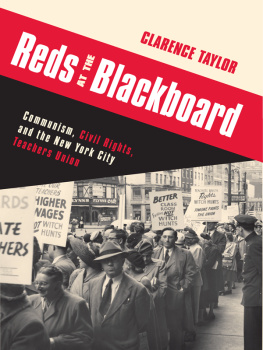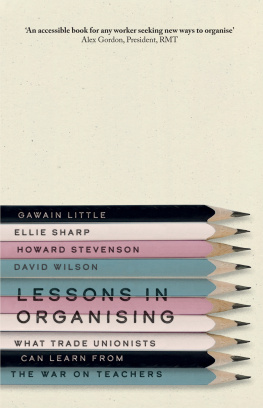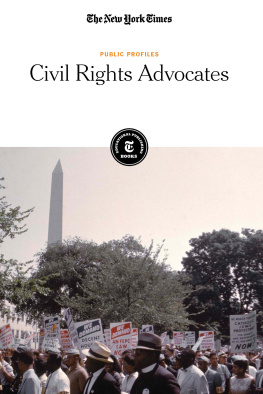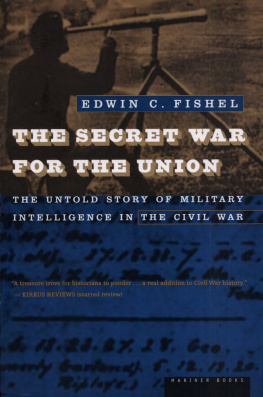REDS AT THE BLACKBOARD
Reds at the Blackboard
COMMUNISM, CIVIL RIGHTS, AND THE NEW YORK CITY TEACHERS UNION
Clarence Taylor
C O L U M B I A U N I V E R S I T Y P R E S S  New York
New York
Columbia University Press
Publishers Since 1893
New York Chichester, West Sussex
cup.columbia.edu
Copyright 2011 Columbia University Press
All rights reserved
E-ISBN 978-0-231-52648-7
Library of Congress Cataloging-in-Publication Data
Taylor, Clarence.
Reds at the blackboard : communism, civil rights, and the New York City Teachers Union / Clarence Taylor
p. cm.
Includes bibliographical references and index.
ISBN 9780231152686 (cloth) : alk. paper) ISBN 9780231526487 (e-book)
1. Teachers Union of the City of New YorkHistory20th century 2. Teachers unionsNew York (State) New York History 20th century. 3. TeachersNew York (State) New York History 20th century. 4. Teachers Political activity New York (State) New York History 20th century. 5. Communism and education New York (State) New York History 20th century. 6. Civil rights New York (State) New York History 20th century. I. Title.
LB2844.53.U62N78 2011
331.88'1137110097471dc22
2010033069
A Columbia University Press E-book.
CUP would be pleased to hear about your reading experience with this e-book at .
References to Internet Web sites (URLs) were accurate at the time of writing. Neither the author nor Columbia University Press is responsible for Web sites that may have expired or changed since the book was prepared.
for
Marsha
CONTENTS
The New York City Teachers Union and the Issue of
Race During the Second World War
12. The Triumph of the United Federation of Teachers
and the Demise of Social Unionism
I am indebted to a number of people who helped me throughout the years I have worked on this book. I wish to thank Jill Hannum, Myrna Chase, and Gail Leggio for their careful reading and editing of the entire manuscript and their very helpful recommendations. I am grateful to Alan Snitlow for reading chapters of the manuscript, for sharing Lucille Spences FBI file and Virginia L. Snitlows essay, Why I Teach Negro Girls, and for recommending Jill Hannum. I am indebted to Jonathan Birnbaum for his carefully reading of . His recommendations for that chapter helped sharpen my major argument in Reds at the Blackboard.
No one has been more supportive of this project than Anne Filardo. Anne encouraged me every step of the way, suggesting people I should interview, allowing me to look at materials on the Teachers Union, and giving me helpful suggestions for shaping the manuscript. Although she passed away before the book was published, I am happy she did read a rough draft of the complete work.
I believe there is no one who has studied the files on the Teachers Union more than Lori Styler and Lisa Harbarkan. I wish to thank both Lisa and Lori for the numerous conversations we had on the Teachers Union, for their willingness to share materials on TU members, and for their suggestions on the several chapters of the manuscript. I also owe a debt to Henry Foner, who has been quite generous with his time and materials on the Rapp-Coudert Committee. Paul Becker was very helpful in providing vital information on the waning days of the Teachers Union.
I am thankful for Carol Smiths friendship and for arranging an interview with Annette Rubinstein in 2005. The staff at the Tamiment Library and Robert F. Wagner Archives at NYU, especially Peter Filardo, Donna Davey, Gail Malmgreen, and Gail Gottfried, were quite diligent in locating material on the Teachers Union with expediency. They were also very encouraging, spending time with me to learn about the project. I wish to thank the staff at Catherwood Library Kheel Center, Cornell Universitys School of Industrial Relations, for their help in locating, and making what seems like countless numbers of copies of the files of, the Teachers Union. The staff of the Walter Reuther Library Manuscripts at Wayne State University was quite generous in allowing me to explore the minutes of the American Federation of Teachers and sending me copies of those minutes in a timely fashion. The staff of the State Library of New York in Albany was also helpful in providing me with the Rapp-Coudert Files. I owe a special debt to David Ment and the archivists in the special collections section of the Library of Teachers College, Columbia University. David and his staff helped me locate the numerous files on the hearings on suspended teachers and other Board of Education records needed for this book.
I am thankful to my friend Douglas R. Egerton for his support. Doug, one of the best historians of the nineteenth century and probably the leading scholar on slave rebellions, claims to know little about the twentieth century. However, my conversations over the years with him about my project prove to me that Doug is quite familiar with cold war history, and I wish to thank him for his recommendations. I am appreciative of the work of Joshua Freeman, Jerald Podair, Martha Biondi, Johanna Fernandez, Barbara Ransby, Daniel Perlstein, Brian Purnell, Jeanne Theoharis, Komazi Woodard, Peter Eisenstadt, Thomas Sugrue, and Wendell Pritchett for their scholarship because it gave me a clearer understanding of the northern freedom struggle.
I owe many thanks to my editor, Philip Leventhal, and to Susan Pensak, senior manuscript editor, at Columbia University Press for their painstaking work in helping to shape the manuscript into a book. Lastly, I wish to thank Marsha for her help with this project. I am convinced she has heard more about the history of the TU and content and organization of Reds at the Blackboard than she really wished to know. Nevertheless, she never complained about my enthusiasm for this project. It is her love and patience that helped me finish Reds at the Blackboard.
The history of the New York City Teachers Union is, in large part, a story of the American left. Some of the most tumultuous battles of the left, including the fight between the Communist Party and Jay Lovestones Communist Party Opposition, the Communists struggle against anti-Communist forces from the 1930s to the McCarthy period of the 1950s, and the battle for civil rights involved the New York City Teachers Union. Reds at the Blackboard examines the struggle to define teacher unionism in the early and middle part of the twentieth century. Once the Communist Rank and File caucus gained control of the Teachers Union in 1935, the union adopted a brand of unionism whose objectives did not limit its activities to the traditional goals of service unionismincreasing salaries and improving working conditions for teachers. Its type of social unionism embraced the struggle for racial equality, child welfare, the advancement of the trade union movement, academic freedom, and better relationships with parents and communities. But the unions association with the Communist Party was problematic.
The New York City Teachers Union was organized in 1916 by a group of teachers who believed that the interest of teachers could be best served by acting collectively. The same year it was organized the Teachers Union received a charter from the American Federation of Teachers, becoming AFT Local 5 and the first teachers union in New York City. The two most important early leaders of Local 5 were Henry Linville and Abraham Lefkowitz. Linville was a biology teacher who received his Ph.D. from Harvard University in 1897. He was chair of the Biology Department at Dewitt Clinton High School, Manhattan, from 1897 to 1908 and chair of the Biology Department at Jamaica High School, Long Island, from 1908 to 1921. Linville was a socialist who supported the steel strike of 1919 (conducted by the Amalgamated Association of Iron, Steel and Tin Workers in an attempt to organize the steel industry), the American Civil Liberties Union, and, like many other socialists, he opposed U.S. involvement in World War I. For nineteen years, from 1916 to 1935, Linville led the Teachers Union. Born in Revish, Hungary in 1884, Abraham Lefkowitz immigrated to the United States in 1885. He received his doctoral degree in education in 1914 from New York University. Lefkowitz served as the TUs legislative representative and vice president until 1935. Linville and Lefkowitzs major objective was to win recognition of teachers as professionals. As professionals, the two TU leaders insisted, teachers should be awarded decent salaries and treated by administrators with respect. Under Linville and Lefkowitz the TU fought against loyalty oaths and for academic freedom. Although Linville and Lefkowitz had the support of the vast majority of TU members, by the early 1920s a group of left-leaning teachers opposed their leadership. The opposition, made up of members of the Communist Party and the Communist Opposition Party, called for organizing the unemployed and private school teachers, pushed for the union to defend classroom teachers against school administrators, and advocated a more confrontational approach toward the Board of Education.
Next page








 New York
New York